Globalisation as a Tool to Combat Poverty: A Critical Assessment
VerifiedAdded on 2020/05/28
|6
|811
|54
Essay
AI Summary
This essay examines the complex relationship between globalization and poverty, exploring whether it serves as a tool to combat poverty or if it exacerbates existing inequalities. The author discusses the role of multinational corporations, economic disparities within and between nations, and the impact of globalization on various aspects of life, including culture, environment, and political frameworks. The essay references economic theories, such as those of Simon Kuznets, and highlights the challenges of corruption and unequal access to resources. It also explores potential solutions, such as responsible globalization, sustainable development, and inclusive policies, to ensure that the benefits of globalization reach all segments of society. The essay concludes with a call for a more equitable and sustainable approach to globalization to reduce poverty and promote economic equality.
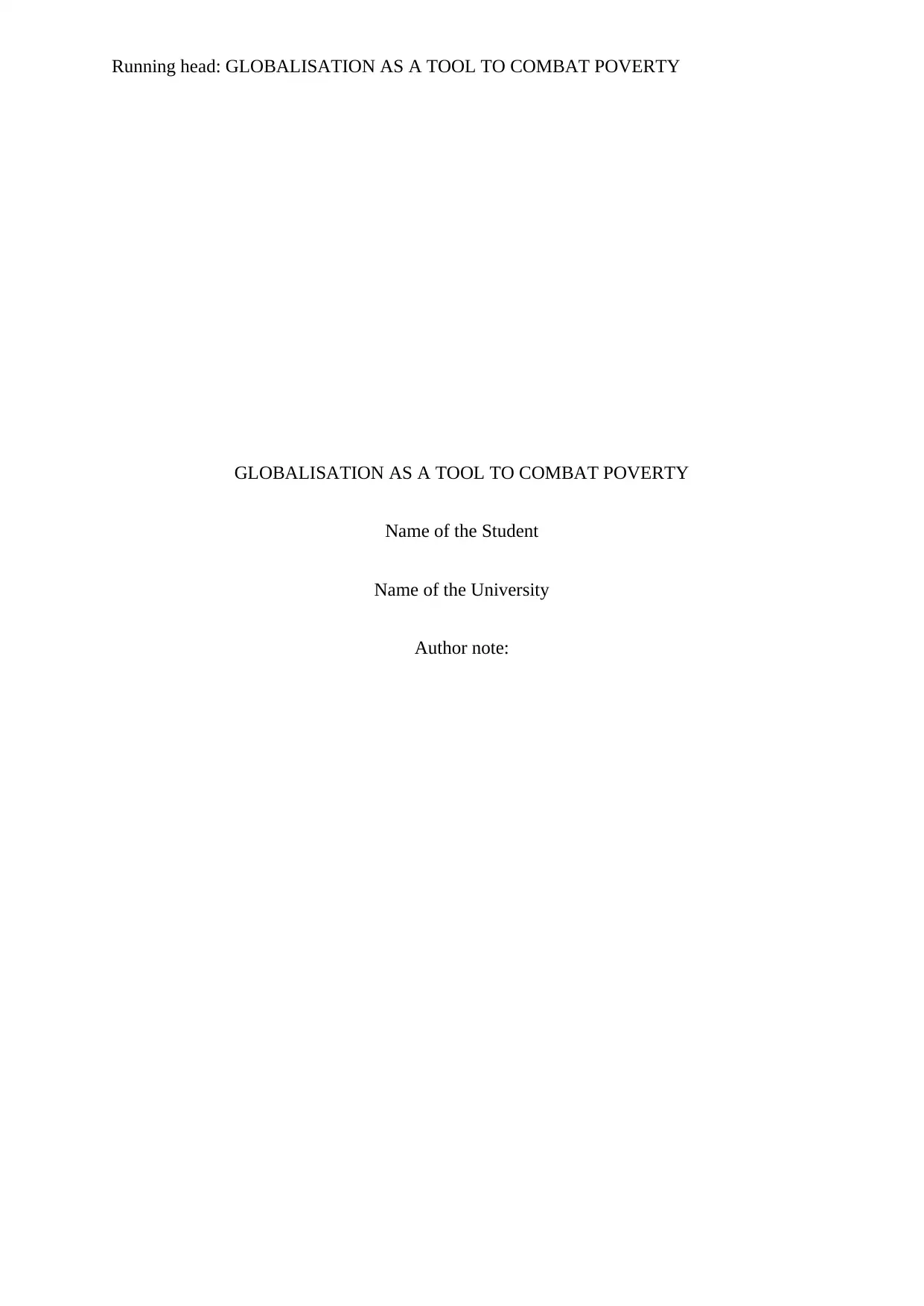
Running head: GLOBALISATION AS A TOOL TO COMBAT POVERTY
GLOBALISATION AS A TOOL TO COMBAT POVERTY
Name of the Student
Name of the University
Author note:
GLOBALISATION AS A TOOL TO COMBAT POVERTY
Name of the Student
Name of the University
Author note:
Paraphrase This Document
Need a fresh take? Get an instant paraphrase of this document with our AI Paraphraser
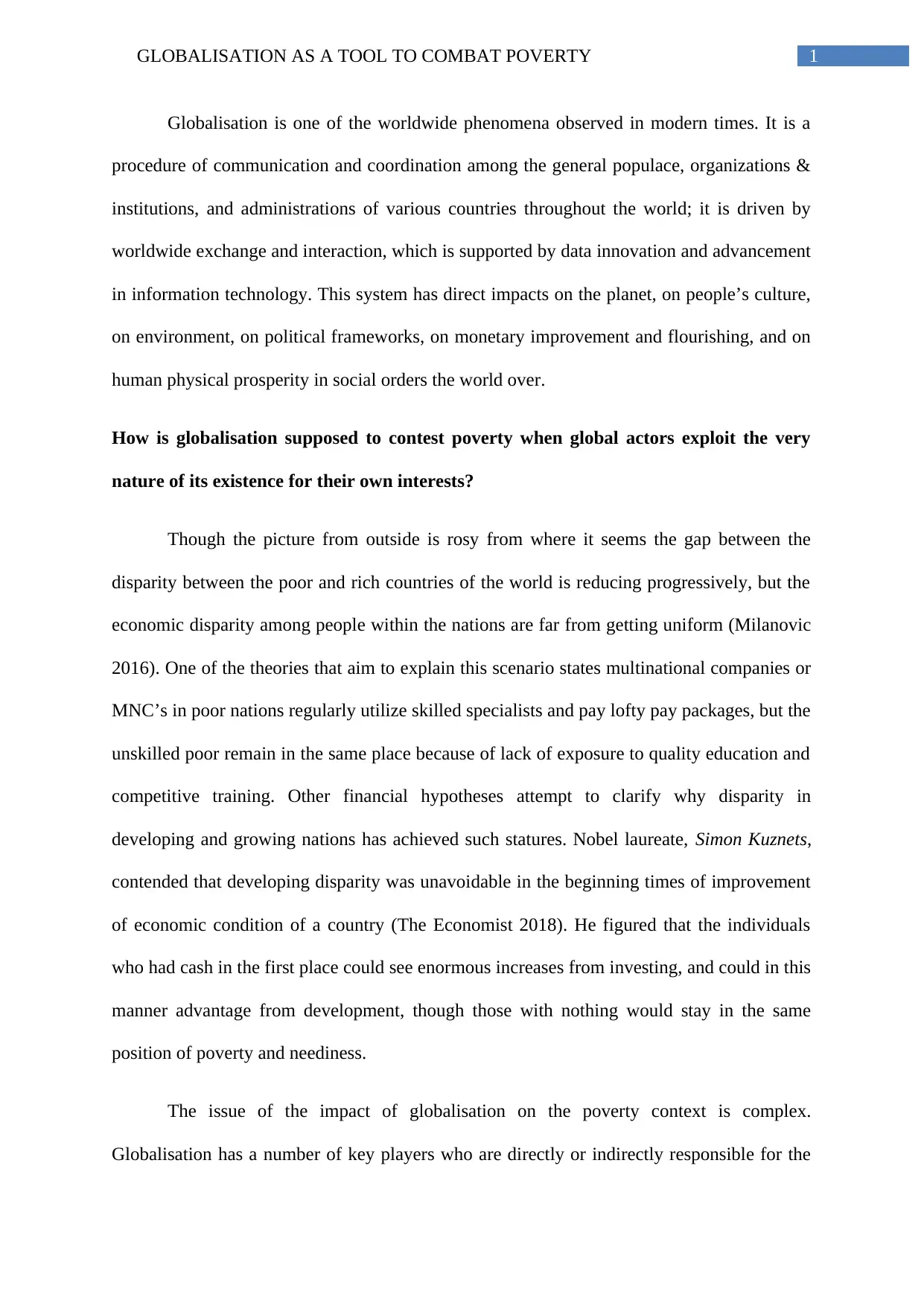
1GLOBALISATION AS A TOOL TO COMBAT POVERTY
Globalisation is one of the worldwide phenomena observed in modern times. It is a
procedure of communication and coordination among the general populace, organizations &
institutions, and administrations of various countries throughout the world; it is driven by
worldwide exchange and interaction, which is supported by data innovation and advancement
in information technology. This system has direct impacts on the planet, on people’s culture,
on environment, on political frameworks, on monetary improvement and flourishing, and on
human physical prosperity in social orders the world over.
How is globalisation supposed to contest poverty when global actors exploit the very
nature of its existence for their own interests?
Though the picture from outside is rosy from where it seems the gap between the
disparity between the poor and rich countries of the world is reducing progressively, but the
economic disparity among people within the nations are far from getting uniform (Milanovic
2016). One of the theories that aim to explain this scenario states multinational companies or
MNC’s in poor nations regularly utilize skilled specialists and pay lofty pay packages, but the
unskilled poor remain in the same place because of lack of exposure to quality education and
competitive training. Other financial hypotheses attempt to clarify why disparity in
developing and growing nations has achieved such statures. Nobel laureate, Simon Kuznets,
contended that developing disparity was unavoidable in the beginning times of improvement
of economic condition of a country (The Economist 2018). He figured that the individuals
who had cash in the first place could see enormous increases from investing, and could in this
manner advantage from development, though those with nothing would stay in the same
position of poverty and neediness.
The issue of the impact of globalisation on the poverty context is complex.
Globalisation has a number of key players who are directly or indirectly responsible for the
Globalisation is one of the worldwide phenomena observed in modern times. It is a
procedure of communication and coordination among the general populace, organizations &
institutions, and administrations of various countries throughout the world; it is driven by
worldwide exchange and interaction, which is supported by data innovation and advancement
in information technology. This system has direct impacts on the planet, on people’s culture,
on environment, on political frameworks, on monetary improvement and flourishing, and on
human physical prosperity in social orders the world over.
How is globalisation supposed to contest poverty when global actors exploit the very
nature of its existence for their own interests?
Though the picture from outside is rosy from where it seems the gap between the
disparity between the poor and rich countries of the world is reducing progressively, but the
economic disparity among people within the nations are far from getting uniform (Milanovic
2016). One of the theories that aim to explain this scenario states multinational companies or
MNC’s in poor nations regularly utilize skilled specialists and pay lofty pay packages, but the
unskilled poor remain in the same place because of lack of exposure to quality education and
competitive training. Other financial hypotheses attempt to clarify why disparity in
developing and growing nations has achieved such statures. Nobel laureate, Simon Kuznets,
contended that developing disparity was unavoidable in the beginning times of improvement
of economic condition of a country (The Economist 2018). He figured that the individuals
who had cash in the first place could see enormous increases from investing, and could in this
manner advantage from development, though those with nothing would stay in the same
position of poverty and neediness.
The issue of the impact of globalisation on the poverty context is complex.
Globalisation has a number of key players who are directly or indirectly responsible for the
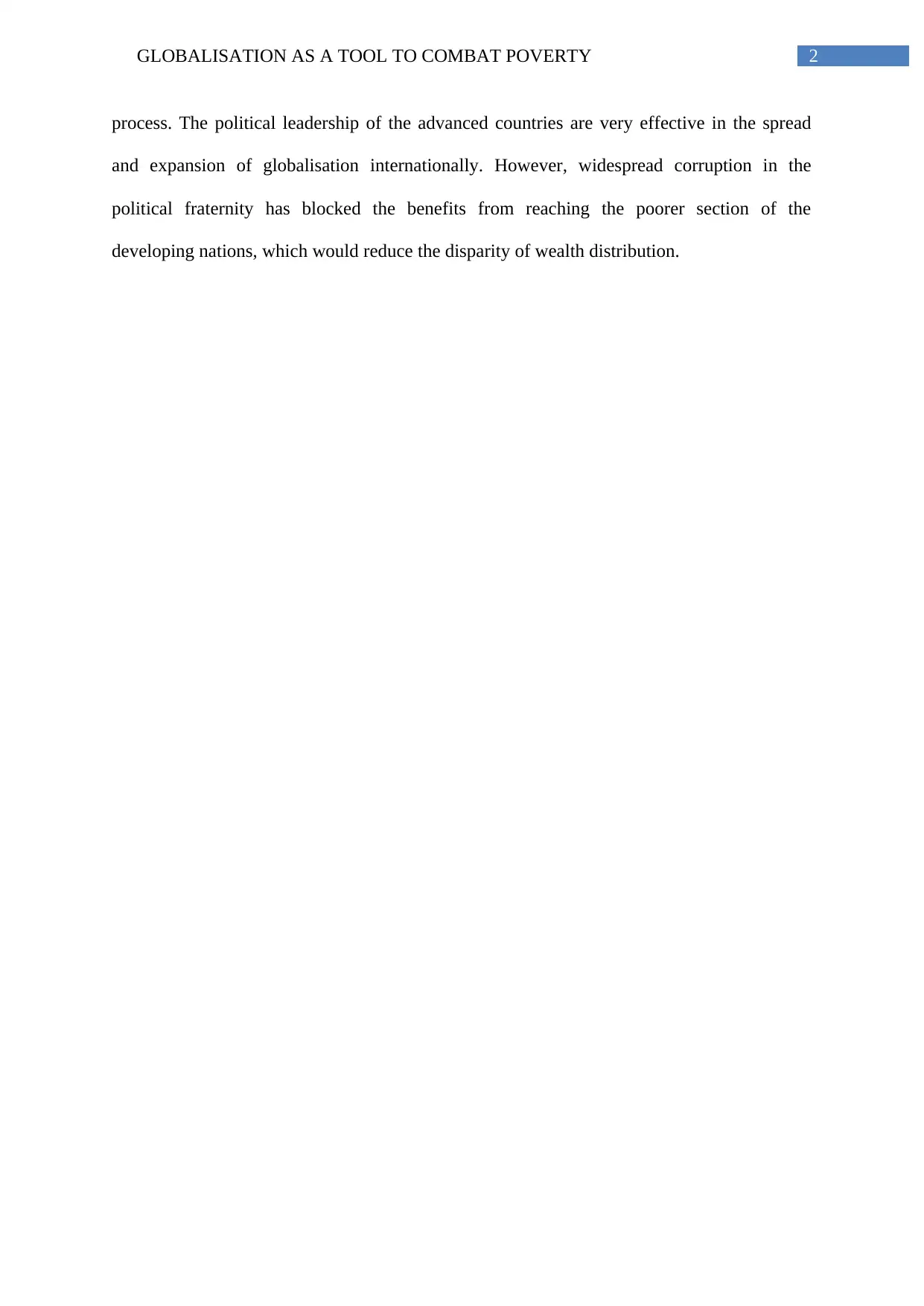
2GLOBALISATION AS A TOOL TO COMBAT POVERTY
process. The political leadership of the advanced countries are very effective in the spread
and expansion of globalisation internationally. However, widespread corruption in the
political fraternity has blocked the benefits from reaching the poorer section of the
developing nations, which would reduce the disparity of wealth distribution.
process. The political leadership of the advanced countries are very effective in the spread
and expansion of globalisation internationally. However, widespread corruption in the
political fraternity has blocked the benefits from reaching the poorer section of the
developing nations, which would reduce the disparity of wealth distribution.
⊘ This is a preview!⊘
Do you want full access?
Subscribe today to unlock all pages.

Trusted by 1+ million students worldwide
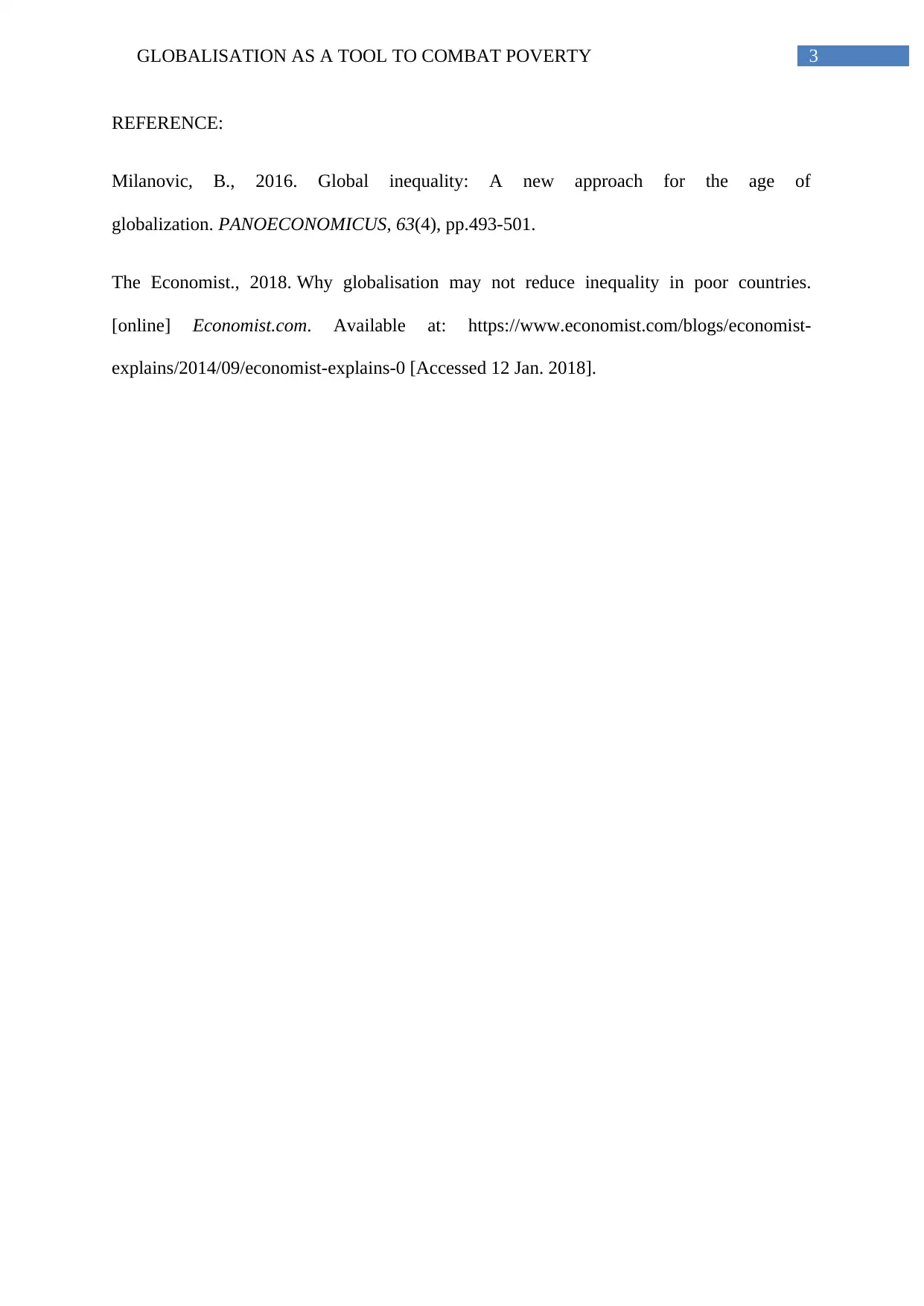
3GLOBALISATION AS A TOOL TO COMBAT POVERTY
REFERENCE:
Milanovic, B., 2016. Global inequality: A new approach for the age of
globalization. PANOECONOMICUS, 63(4), pp.493-501.
The Economist., 2018. Why globalisation may not reduce inequality in poor countries.
[online] Economist.com. Available at: https://www.economist.com/blogs/economist-
explains/2014/09/economist-explains-0 [Accessed 12 Jan. 2018].
REFERENCE:
Milanovic, B., 2016. Global inequality: A new approach for the age of
globalization. PANOECONOMICUS, 63(4), pp.493-501.
The Economist., 2018. Why globalisation may not reduce inequality in poor countries.
[online] Economist.com. Available at: https://www.economist.com/blogs/economist-
explains/2014/09/economist-explains-0 [Accessed 12 Jan. 2018].
Paraphrase This Document
Need a fresh take? Get an instant paraphrase of this document with our AI Paraphraser
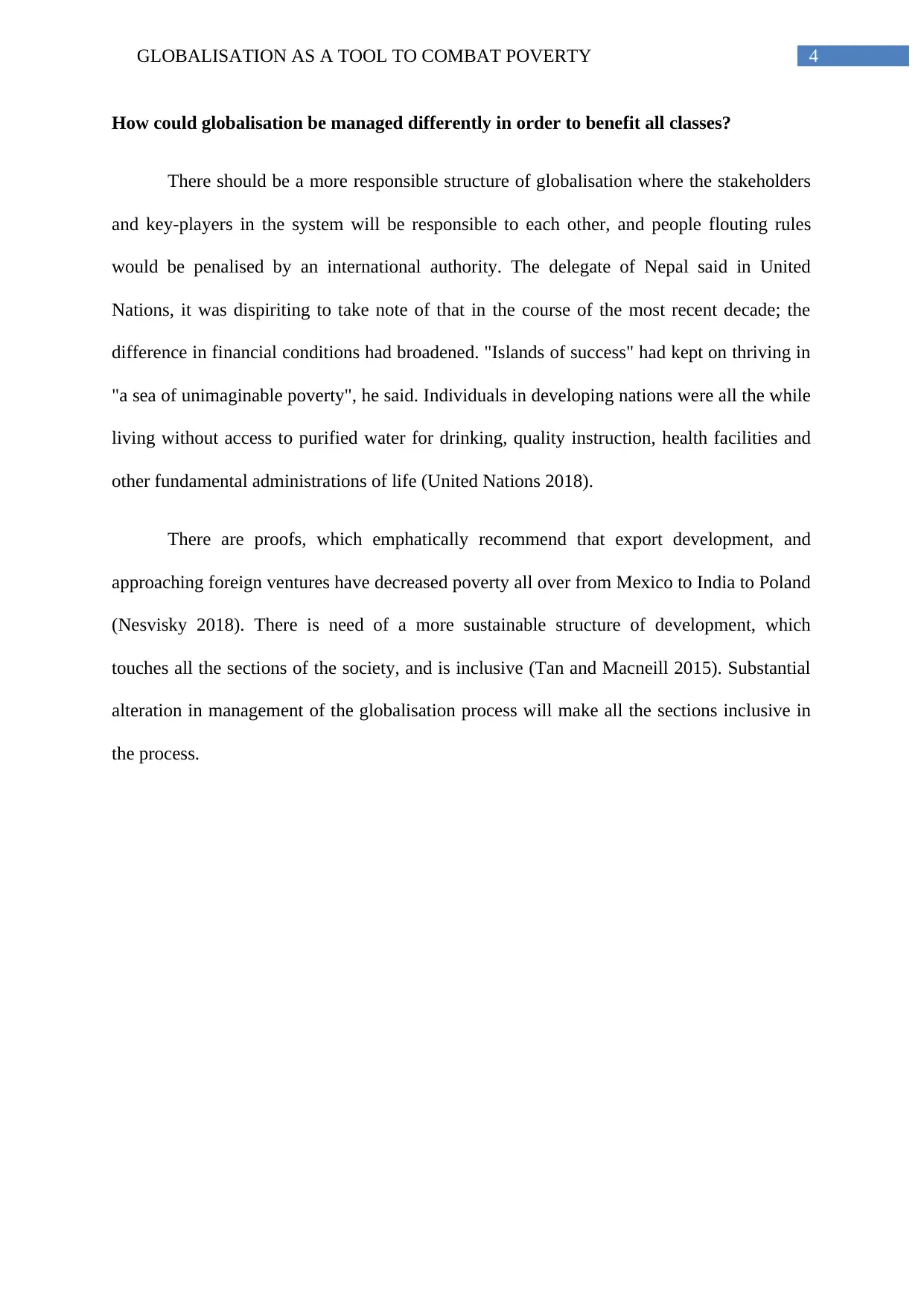
4GLOBALISATION AS A TOOL TO COMBAT POVERTY
How could globalisation be managed differently in order to benefit all classes?
There should be a more responsible structure of globalisation where the stakeholders
and key-players in the system will be responsible to each other, and people flouting rules
would be penalised by an international authority. The delegate of Nepal said in United
Nations, it was dispiriting to take note of that in the course of the most recent decade; the
difference in financial conditions had broadened. "Islands of success" had kept on thriving in
"a sea of unimaginable poverty", he said. Individuals in developing nations were all the while
living without access to purified water for drinking, quality instruction, health facilities and
other fundamental administrations of life (United Nations 2018).
There are proofs, which emphatically recommend that export development, and
approaching foreign ventures have decreased poverty all over from Mexico to India to Poland
(Nesvisky 2018). There is need of a more sustainable structure of development, which
touches all the sections of the society, and is inclusive (Tan and Macneill 2015). Substantial
alteration in management of the globalisation process will make all the sections inclusive in
the process.
How could globalisation be managed differently in order to benefit all classes?
There should be a more responsible structure of globalisation where the stakeholders
and key-players in the system will be responsible to each other, and people flouting rules
would be penalised by an international authority. The delegate of Nepal said in United
Nations, it was dispiriting to take note of that in the course of the most recent decade; the
difference in financial conditions had broadened. "Islands of success" had kept on thriving in
"a sea of unimaginable poverty", he said. Individuals in developing nations were all the while
living without access to purified water for drinking, quality instruction, health facilities and
other fundamental administrations of life (United Nations 2018).
There are proofs, which emphatically recommend that export development, and
approaching foreign ventures have decreased poverty all over from Mexico to India to Poland
(Nesvisky 2018). There is need of a more sustainable structure of development, which
touches all the sections of the society, and is inclusive (Tan and Macneill 2015). Substantial
alteration in management of the globalisation process will make all the sections inclusive in
the process.
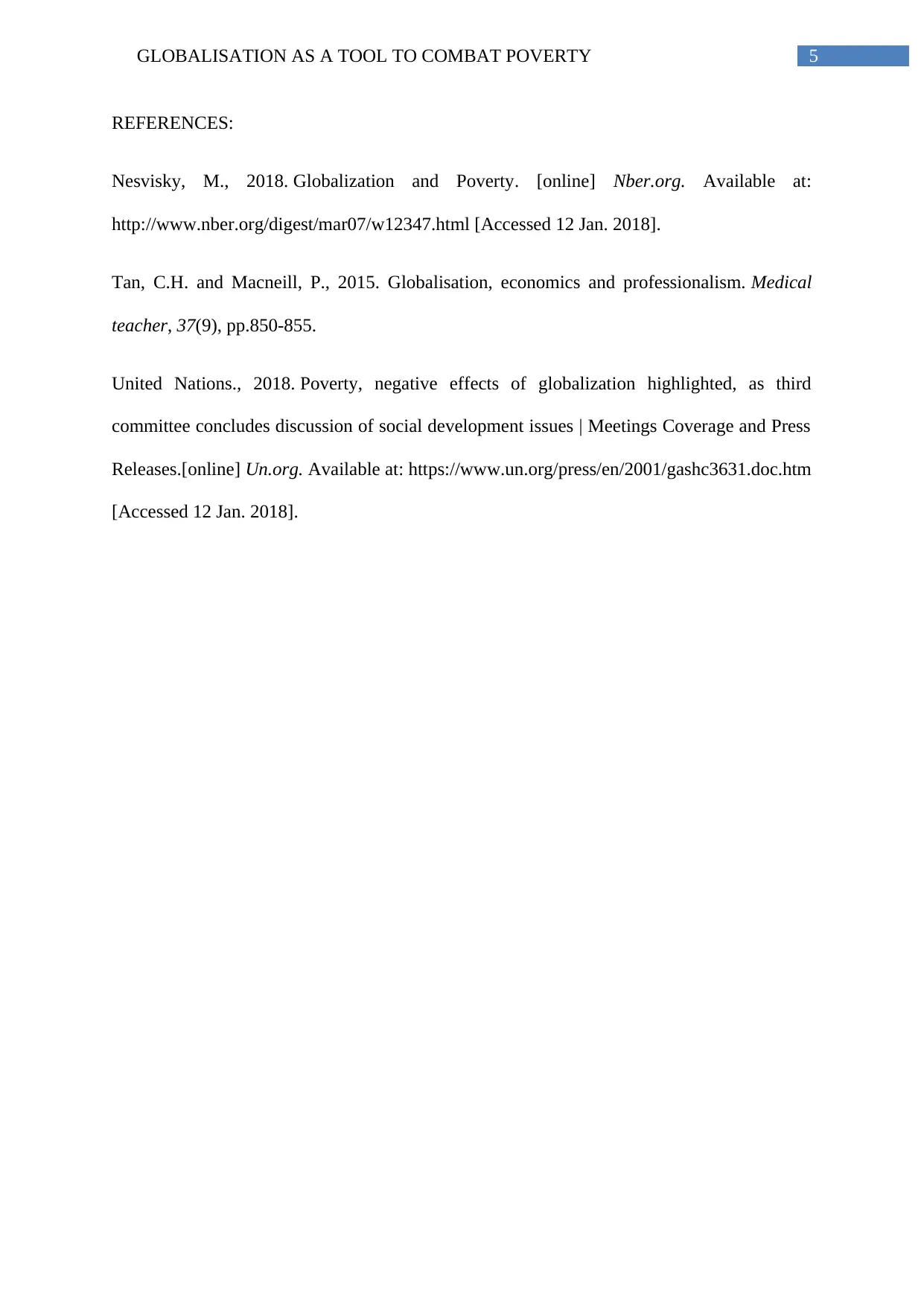
5GLOBALISATION AS A TOOL TO COMBAT POVERTY
REFERENCES:
Nesvisky, M., 2018. Globalization and Poverty. [online] Nber.org. Available at:
http://www.nber.org/digest/mar07/w12347.html [Accessed 12 Jan. 2018].
Tan, C.H. and Macneill, P., 2015. Globalisation, economics and professionalism. Medical
teacher, 37(9), pp.850-855.
United Nations., 2018. Poverty, negative effects of globalization highlighted, as third
committee concludes discussion of social development issues | Meetings Coverage and Press
Releases.[online] Un.org. Available at: https://www.un.org/press/en/2001/gashc3631.doc.htm
[Accessed 12 Jan. 2018].
REFERENCES:
Nesvisky, M., 2018. Globalization and Poverty. [online] Nber.org. Available at:
http://www.nber.org/digest/mar07/w12347.html [Accessed 12 Jan. 2018].
Tan, C.H. and Macneill, P., 2015. Globalisation, economics and professionalism. Medical
teacher, 37(9), pp.850-855.
United Nations., 2018. Poverty, negative effects of globalization highlighted, as third
committee concludes discussion of social development issues | Meetings Coverage and Press
Releases.[online] Un.org. Available at: https://www.un.org/press/en/2001/gashc3631.doc.htm
[Accessed 12 Jan. 2018].
⊘ This is a preview!⊘
Do you want full access?
Subscribe today to unlock all pages.

Trusted by 1+ million students worldwide
1 out of 6
Related Documents
Your All-in-One AI-Powered Toolkit for Academic Success.
+13062052269
info@desklib.com
Available 24*7 on WhatsApp / Email
![[object Object]](/_next/static/media/star-bottom.7253800d.svg)
Unlock your academic potential
Copyright © 2020–2025 A2Z Services. All Rights Reserved. Developed and managed by ZUCOL.





